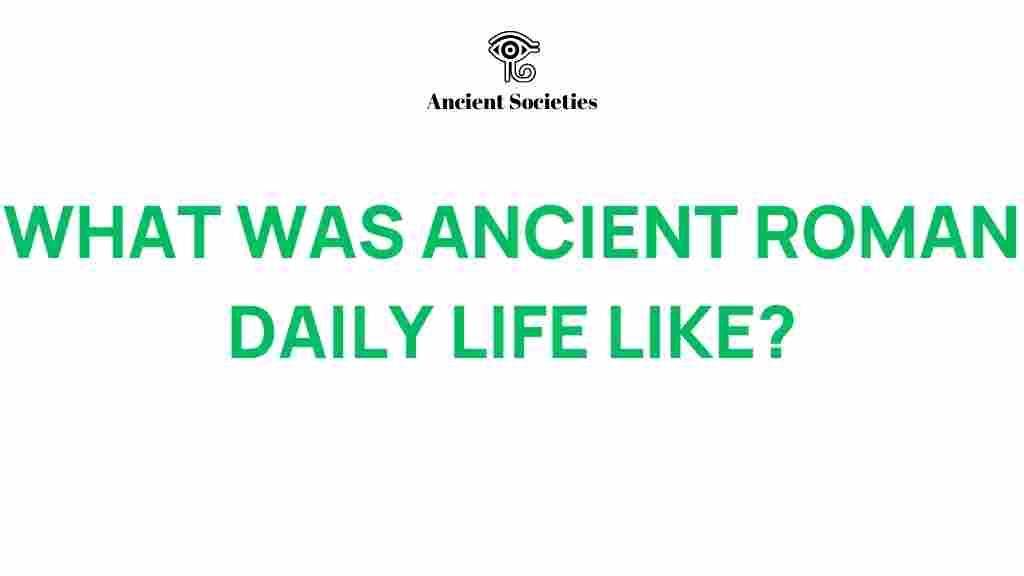Unveiling the Secrets of Ancient Roman Daily Life
Ancient Rome, a civilization that has profoundly influenced modern culture, society, and architecture, was characterized by its rich traditions and customs. The daily life of Romans varied significantly based on social class, occupation, and geographical location. Understanding their lifestyle provides a window into the complexities of their society and the foundations of Western civilization.
The Structure of Roman Society
The society of Ancient Rome was hierarchical and structured, consisting primarily of three main classes:
- Patricians: The aristocratic families who held most of the political power.
- Equestrians: Wealthy merchants and landowners who were often involved in trade and commerce.
- Plebeians: The common people, including farmers, laborers, and soldiers.
Each class had its own customs and daily routines, reflecting their status and lifestyle.
Daily Life in Ancient Rome
Daily life in Ancient Rome was marked by various activities that differed across social strata. Here’s a glimpse into the routine of a typical Roman citizen:
Morning Rituals
The day began at dawn. Romans would often start their day with a light breakfast called ientaculum, typically consisting of:
- Bread
- Cheese
- Fruit
- Honey
Following breakfast, many would head to the forum to engage in business or attend political discussions. Wealthy Romans often had slaves to manage household duties.
Work and Occupations
The type of work a Roman did was largely dictated by their social class:
- Patricians: Engaged in politics, law, and high-status professions.
- Equestrians: Focused on trade, banking, and administration.
- Plebeians: Worked as farmers, artisans, or laborers.
Many Romans also participated in public works, helping to build the city’s impressive architecture, which remains a symbol of their ingenuity.
Cultural and Social Activities
The culture of Ancient Rome was vibrant and multifaceted, encompassing arts, religion, and entertainment. The Romans celebrated numerous festivals, which were integral to their daily life.
Traditions and Festivals
Among the most popular festivals were:
- Saturnalia: A week-long festival honoring the god Saturn, characterized by feasting, gift-giving, and role reversals.
- Lupercalia: A fertility festival celebrated in February.
- Consualia: Celebrated in honor of the god Consus, featuring horse racing and games.
These festivals reflected the Romans’ deep religious beliefs and their connection to gods and goddesses, highlighting the importance of tradition in their daily life.
Leisure and Entertainment
Leisure time in Ancient Rome was cherished, with various forms of entertainment available:
- Chariot Races: Held at the Circus Maximus, these races were extremely popular among all social classes.
- Gladiatorial Games: Held in amphitheaters, these brutal contests drew large crowds.
- Theater Performances: Romans enjoyed plays, often depicting mythological stories or social satire.
Public baths were also a central social hub. Romans would visit baths not just for hygiene but for relaxation and socializing.
Architecture and Urban Life
The architecture of Ancient Rome is a testament to their advanced engineering skills. Iconic structures that defined Roman urban life include:
- Colosseum: An architectural marvel that hosted gladiatorial contests.
- Pantheon: A temple dedicated to the gods, known for its magnificent dome.
- Aqueducts: Ingeniously designed to transport water from distant sources into cities.
These architectural achievements not only served functional purposes but also symbolized the power and sophistication of Roman society.
Food and Dining Customs
The diet of Ancient Romans varied by class. While the wealthy indulged in lavish meals, the common people had simpler fare. Common foods included:
- Grains (primarily wheat)
- Legumes (lentils and chickpeas)
- Vegetables (cabbage, onions, garlic)
- Fish and meats (for the wealthy)
Dining customs also varied. The elite often hosted elaborate dinners called convivia, where guests reclined on couches while enjoying multiple courses.
Family Life and Gender Roles
Family was at the heart of Roman life. The paterfamilias, or male head of the household, held significant authority. Women, while generally responsible for managing the household, could own property and engage in business:
- Men: Typically involved in public life, politics, and work.
- Women: Managed household affairs and reared children, with some engaging in social and economic activities.
Children were educated at home or in schools, learning skills vital for their future roles in society.
Challenges of Daily Life
Life in Ancient Rome was not without its challenges. Common issues faced by Romans included:
- Poverty: Many plebeians struggled to make ends meet.
- Health: Diseases and limited medical knowledge led to high mortality rates.
- Political Instability: Frequent changes in leadership and civil unrest affected daily life.
Despite these challenges, the resilience of the Roman people is evident in their enduring legacy.
Conclusion
Exploring the daily life of Ancient Rome reveals a civilization rich in culture, traditions, and societal structure. From their architectural marvels to their vibrant festivals, the Romans set foundations that continue to influence our modern world today. Understanding Ancient Rome and its daily life enriches our perspective on history, culture, and the evolution of society.
For more insights into the fascinating history of Ancient Rome, be sure to check out this comprehensive guide.
If you’re interested in learning more about Roman architecture, visit our dedicated section for detailed articles and resources.
This article is in the category Culture and created by AncientSocieties Team
